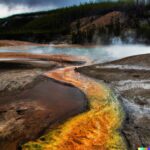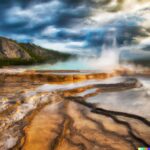Yellowstone National Park is renowned for its stunning geothermal features, including geysers, hot springs, and fumaroles. But what exactly is Yellowstone geothermal activity, and how does it affect the environment?
In this article, we will explore the main geothermal features in Yellowstone, the impact on air and water quality, and the effects on plant and animal life. We will also discuss how geothermal activity contributes to climate change and examine both the positive aspects and negative effects of this natural phenomenon.
Join us as we delve into the environmental impact of Yellowstone geothermal activity.
What is Yellowstone Geothermal Activity?
Yellowstone Geothermal Activity refers to the natural phenomena present in the Yellowstone National Park characterized by geysers, hot springs, and other thermal features.
These unique geothermal features in Yellowstone play a crucial role in shaping the park’s ecosystem. Geysers, such as the famous Old Faithful, erupt with scalding water and steam, providing habitats for thermophilic bacteria and algae. Hot springs, like the vibrant Grand Prismatic Spring, support diverse microorganisms adapted to extreme temperatures.
The conservation efforts in Yellowstone focus on maintaining the delicate balance of these geothermal features to ensure the sustainability of the park’s ecosystem, protecting them from human interference and environmental changes.
What Are the Main Geothermal Features in Yellowstone?
Yellowstone boasts a diverse range of geothermal features, including iconic hot springs, geysers, and fascinating geological formations that showcase the park’s volcanic history and thermal activity.
These incredible geothermal features in Yellowstone offer a glimpse into the powerful forces of nature at work. The hot springs, with their vibrant hues and bubbling, steaming waters, are a testament to the park’s rich mineral deposits and unique microbial life. Geysers like Old Faithful captivate visitors with their dramatic eruptions, shooting scalding water into the air in a mesmerizing display. The sight of these geothermal wonders against the backdrop of the park’s lush forests and rugged mountains creates a truly awe-inspiring experience for all who visit Yellowstone.
How Does Geothermal Activity Affect the Environment?
Geothermal activity in Yellowstone can have significant environmental impacts, affecting habitats, wildlife, and the delicate balance of the ecosystem.
The release of geothermally heated water and gases can alter the landscape by changing vegetation patterns and creating geothermal features like hot springs and geysers. These changes can lead to habitat loss for certain plant and animal species that are unable to adapt to the new conditions. This disruption in habitat can have cascading effects on the entire ecosystem, potentially impacting the food chain and biodiversity within the area.
Endangered species may face heightened risks as their habitats are disturbed, further exacerbating their vulnerable status.
What is the Impact on Air Quality?
The geothermal activity in Yellowstone can influence air quality through emissions of gases and particulate matter, prompting the need for stringent pollution control measures to mitigate environmental harm.
- Geothermal features such as hot springs, geysers, and fumaroles release pollutants like sulfur dioxide, hydrogen sulfide, and carbon dioxide into the atmosphere.
- These emissions can react with other compounds in the air, leading to the formation of secondary pollutants like sulfuric acid and nitrogen oxides.
Such pollutants not only contribute to smog formation but also have the potential to harm human health and ecosystems.
The implementation of effective pollution control strategies is crucial to preserve the pristine environment of Yellowstone National Park and reduce the negative impacts of geothermal emissions on air quality.
How Does Geothermal Activity Affect Water Quality?
Geothermal activity in Yellowstone can affect water quality in the park, necessitating rigorous environmental monitoring to safeguard the purity of aquatic ecosystems from potentially harmful contaminants.
This monitoring effort is crucial in assessing contamination risks and ensuring the protection of fragile aquatic habitats within the park’s ecosystem. Through the use of advanced techniques such as water sampling, chemical analysis, and microbial monitoring, park authorities can closely track any changes in water quality levels.
By implementing proactive measures like buffer zones around geothermal features, proper waste disposal practices, and education programs for visitors, Yellowstone strives to minimize the impact of geothermal activity on its pristine water bodies. Environmental monitoring practices play a pivotal role in maintaining the delicate balance of the park’s natural environment and conserving its biodiversity.
What Are the Effects on Plant and Animal Life?
The geothermal activity in Yellowstone can disrupt plant and animal life, causing alterations to the natural ecosystems and biodiversity within the park.
This disruption can lead to challenges for wildlife, as certain species may struggle to adapt to the changing conditions brought about by the geothermal features. For plants, the extreme temperatures and chemical compositions of geothermal areas can limit their growth and survival. The disturbances caused by geothermal activity can impact the availability of food sources for animals, potentially leading to shifts in population dynamics and behaviors as they seek out new resources in the altered landscape.
How Does Geothermal Activity Contribute to Climate Change?
Geothermal activity in Yellowstone can contribute to climate change through the release of carbon emissions, highlighting the need to address the environmental implications of geothermal energy production.
- These emissions stem from the underground reservoirs of hot water and steam that heat up underground rocks, releasing gases like carbon dioxide and methane into the atmosphere.
- This process occurs when the geothermal features interact with the surrounding volcanic activity.
The environmental impacts extend beyond greenhouse gas emissions to include effects on local ecosystems and overall biodiversity. As we consider the sustainability of geothermal energy, it becomes crucial to strike a balance between harnessing this renewable resource and ensuring minimal ecological disruption in places like Yellowstone National Park.
What Are the Positive Aspects of Yellowstone Geothermal Activity?
Despite its environmental challenges, Yellowstone geothermal activity presents positive aspects such as the potential for geothermal energy production, offering a renewable resource for sustainable practices.
The utilization of geothermal energy derived from sources like those found in Yellowstone plays a significant role in reducing greenhouse gas emissions and dependence on fossil fuels, contributing to a cleaner environment and combating climate change. By tapping into the earth’s heat, geothermal power plants can generate consistent electricity, providing a stable energy source that complements intermittent renewable sources like wind and solar power.
Conservation efforts in Yellowstone aim to protect these geothermal features while exploring their sustainable energy generation potential.
Can Geothermal Energy be Used as a Renewable Resource?
Geothermal energy extracted from Yellowstone can be harnessed as a sustainable and renewable resource, offering opportunities for geothermal heating applications and environmentally friendly energy solutions.
By tapping into the natural heat beneath the surface of Yellowstone National Park, geothermal systems can provide efficient heating for residential, commercial, and industrial properties. This process involves utilizing the heat stored in the Earth to generate power for heating purposes, reducing reliance on traditional fossil fuels. Geothermal energy also helps in fostering sustainable energy practices by minimizing greenhouse gas emissions and supporting a cleaner environment. The use of geothermal energy not only reduces the carbon footprint but also helps in maintaining the delicate ecological balance of the park.
What Are the Benefits of Geothermal Pools for Ecosystems?
The geothermal pools in Yellowstone provide essential benefits to the local ecosystem, supporting biodiversity, thermal habitats, and geothermal conservation efforts.
These pools serve as hotspots of biodiversity, fostering the existence of unique microorganisms and species specially adapted to extreme thermal conditions. The geothermal features create diverse habitats that support a wide range of plant and animal life, contributing to the overall ecological balance of the region. Conservation initiatives focused on preserving geothermal areas in Yellowstone play a crucial role in maintaining these thermal habitats and ensuring the sustainability of this geologically dynamic ecosystem.
What Are the Negative Effects of Geothermal Activity?
While beneficial in many ways, geothermal activity in Yellowstone also poses negative effects such as impacts on tourism and potential hazards associated with geysers and hot springs.
The disruptions to tourism in Yellowstone due to geothermal activity can cause economic repercussions for businesses that depend on visitor traffic. Visitors may encounter unexpected closures of popular attractions, leading to dissatisfaction and affecting local economies. The hazards related to geysers and hot springs can be severe, including burns from scalding hot water or toxic gas emissions. It is vital for visitors and residents alike to exercise caution and adhere to safety guidelines while exploring the park’s geothermal features.
How Does Geothermal Activity Affect Tourism?
Geothermal activity in Yellowstone can impact tourism by influencing visitor experiences, environmental balance, and the management of geothermal attractions within the park.
Visitors to Yellowstone often find themselves captivated by the stark beauty and power of the geothermal features scattered throughout the park, which include iconic geysers like Old Faithful and colorful hot springs such as the Grand Prismatic Spring. These natural wonders create a unique and immersive experience for tourists, allowing them to witness the Earth’s raw energy up close. The presence of geothermal activity also requires careful consideration to maintain the delicate ecological balance of the area and ensure the safety of both visitors and the environment.
What Are the Dangers of Geysers and Hot Springs?
Geysers and hot springs in Yellowstone pose inherent dangers to visitors due to their unpredictable nature and the potential risks associated with geothermal features.
It is crucial for individuals to exercise caution when navigating these natural wonders, as the scalding hot water can cause severe burns in a matter of seconds. In addition to the physical risks, geothermal features emit toxic gases that can be harmful if inhaled in large quantities. Visitors should remain on designated boardwalks and viewing platforms to maintain a safe distance from the hazardous areas.
Understanding and respecting the power of these natural phenomena is essential in ensuring both personal safety and the preservation of Yellowstone’s unique geothermal environment.
What Are the Long-term Consequences of Geothermal Activity on the Environment?
The long-term consequences of geothermal activity in Yellowstone may include ecological effects, conservation challenges, and the need for sustainable practices to mitigate environmental impacts.
These lasting impacts affect the delicate ecological balance in the park, with geothermal features shaping habitats for unique species. Conservation efforts are crucial to protect these ecosystems from disruption while ensuring visitor enjoyment. Implementing sustainable practices, such as responsible tourism and resource management, becomes imperative to preserve Yellowstone’s natural wonders for future generations. By understanding the interconnectedness of geothermal activity with biodiversity and ecosystems, a harmonious coexistence can be achieved, fostering a thriving environment for all inhabitants of this iconic national park.
Last Updated on February 7, 2024 by Jon Waraas – Originally Posted: February 7, 2024

I’m Jon Waraas, and I’ve been navigating the online world since 2006. By day, I’m the proud owner of some eCommerce gems, and by night, I’m the voice behind the adventures on Waraas.Com.
My heart, however, belongs to the wild beauty of Yellowstone National Park. I’ve got a collection of websites dedicated to sharing the wonders of this natural masterpiece. Oh, and did I mention? I’m currently building my own cabin inside the ghost town of Gilmore, Idaho – a cabin with tales to tell!
When I’m not immersed in the digital realm, you’ll find me lacing up my boots for a good hike or setting up camp under the star-studded sky.




